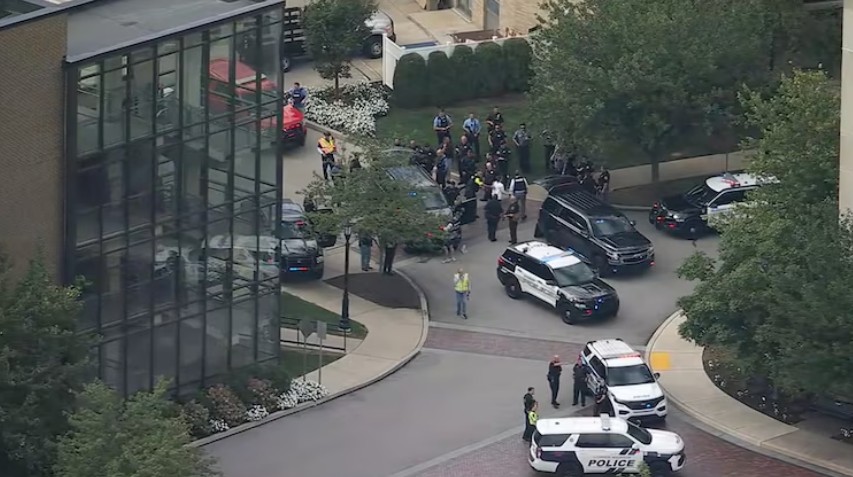
Nearly a dozen school shooting hoaxes at universities have been reported across the country in the past week, with at least 10 of those believed to be connected to a single group, according to an intelligence report.
While these particular hoaxes, also known as “swatting calls,” ended up being false alarms, experts note that these types of hoaxes are not only a serious crime with substantial penalties for those involved, but can also put first responders and bystanders at risk.
“Swatting is not a benign endeavor. Law enforcement is taking it seriously…when they are identified, they are arresting them and prosecuting them,” said John Cohen, an ABC News contributor and a former acting undersecretary at the Department of Homeland Security.
In an intelligence report on Wednesday, Center for Internet Security and Institute for Strategic Dialogue analysts said members of “Purgatory” — a swatting group — “very likely made false emergency reports targeting at least 10 U.S. universities” between Aug. 21 and Aug. 25.
“These calls resulted in lockdowns, panic and significant disruptions to campus operations,” the report said.
The swatting calls — which Cohen defines as a “malicious reporting of a fictitious emergency with the purposes of eliciting a law enforcement response” — are not a new phenomenon, with people previously calling 911 from pay phones “hoping to create these types of response scenarios,” Cohen said. But, what’s different now is the increase in technology that create a more realistic threat to police, Cohen said.
On Monday, the University of Colorado Boulder responded to a report from an individual who claimed there was an active shooter and that they heard gunshots coming from the direction of a campus library. But once on the scene, “there were no findings of injuries or any suspect,” the school said.
“The University of Colorado Boulder was the latest target in a string of hoaxes directed at campuses around the country with false active-harmer reports,” the school said.
That same day, there were also false threats reported at the University of New Hampshire, University of Arkansas, Iowa State University, Northern Arizona University and Kansas State University.
On Sunday, the University of South Carolina received two separate calls of an active shooter at a campus library, with the calls including “background noise that mimicked gunfire,” the school said. Last week, there were also swatting calls placed at Villanova University and the University of Tennessee in Chattanooga, the schools said.
“This is a serious issue. It is a crime. It is wrong. We are taking care of that,” Radnor Township Superintendent of Police Christopher Flanagan said after the Villanova University shooting hoax last week.
While law enforcement is still attempting to understand the motive behind these hoaxes, Cohen said swatting is typically used to “threaten or harass public officials, to disrupt public events or acquire ill-gotten gain or using it as part of an extortion technique.”
Bob Boyce, an ABC News contributor and retired NYPD chief of detectives, said these calls can range from a “simple prank” to revenge, or even a pursuit of notoriety. But regardless of the motive, there are serious penalties at stake for those placing these swatting calls, Boyce said.
Federal charges can include false information and hoaxes; which could lead to up to five years in prison with a “substantial fine;” interstate transmission of threat; which could lead to up to 20 years in jail if there is an injury involved; and wire fraud, which constitutes a “substantial penalty, incarceration and fines,” Boyce said.
“Now is the time to prosecute these individuals and put it out there that these people are going to jail, or possibly could go to jail after prosecution,” Boyce told ABC News.
In February, federal prosecutors said a California teenager, Alan Filion, was sentenced to 48 months in prison for making over 375 swatting and threat calls, where they say he “claimed to have planted bombs in the targeted locations or threatened to detonate bombs and/or conduct mass shootings at those locations.”
Boyce said the FBI also has a virtual online command center to log these swatting calls, where they can keep track of how many have happened and analyze if there is a pattern in order to determine potential suspects.
In a statement to ABC News, the FBI said they are aware of the recent swatting incidents and are “working with our law enforcement partners.”
“The FBI is seeing an increase in swatting events across the country, and we take potential hoax threats very seriously because it puts innocent people at risk. Knowingly providing false information to emergency service agencies about a possible threat to life drains law enforcement resources, costs thousands of dollars, and, most importantly, puts innocent people at risk,” the agency said.
The FBI added, “We work closely with our law enforcement partners to determine their credibility, share information, and take appropriate investigative action. As always, we encourage members of the public to remain vigilant and immediately report anything they consider suspicious to law enforcement.”